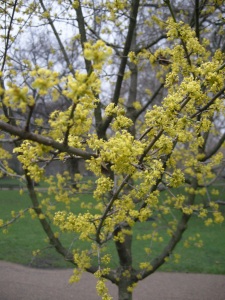Position: Thrives full sun to partial shade
Soil: Moist but well drained
Flowering period: Mid winter.
Eventual Height: 4m
Eventual Spread: 4m
Hardiness: 4a, 4b, 5a, 5b, 6a, 6b, 7a, 7b, 8a, 8b, 9a
Family: Cornaceae
Cornus mas is a large shrub or small tree that has an open, spreading habit. Certain cultivars or pruning techniques may result in a more tree like appearance. In England it will produce umbels on bare branches in winter before the new shoots are produced. The umbels are about 2cm across and made up of tiny star shaped yellow flowers. Oblong, cherry red edible fruit follows these and are produced in autumn. The leaves of the plant are ovate and dark green and will sometimes give excellent autumn purple colours.
Cornus mas, commonly known as the Cornelian Cherry or European Cornel, is native to southern Europe and southwest Asia where it has been cultivated since ancient times. In ancient Greece it was valued for its wood (which sinks in water) which was used to make tools, weapons and even machine parts. It is grown for its fruit in south east Europe where it is popularly used to make preserves. The fruit needs to be fully ripe before a palatable flavour is produced and its astringent qualities abate. The fruit will not ripen fully on the plant and must be kept after harvesting.
The etymological root of the binomial name Cornus is derived from the Latin cornus meaning ‘horn’, due to its dense properties and was originally the old name for this plant. Mas meaning male, derived form another of its names the Male Cornel (given to this plant by John Gerard in 1597).
Cornus mas is useful to the landscape architect as it produces bright yellow flowers during the gloomy winter months and red/ purple leaves during autumn.
Ecologically, Cornus mas berries are eaten by some mammals and many birds. The leaves provide food for some moths and caterpillars. The flowers are attractive to pollinating insects.
The Royal Horticultural Society have given Cornus mas their prestigious Award of Garden Merit.
Cornus mas prefers moist, fertile, well-drained soils. It tolerates most pH of soil.
Cornus mas requires little or no maintenance, just the removal of any unwanted branches during the winter months. It can be intensively pruned to produce a tree form. It can be pruned back to the stump from where it will re-grow if found on sites where it has become unsightly and needs to be retrained.






3 Responses to “Cornus mas”